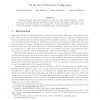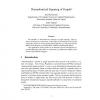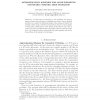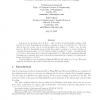APPROX
2005
Springer
14 years 11 months ago
2005
Springer
Traditionally, a fundamental assumption in evaluating the performance of algorithms for sorting and selection has been that comparing any two elements costs one unit (of time, work...
APPROX
2005
Springer
14 years 11 months ago
2005
Springer
Optimal dispersers have better dependence on the error than optimal extractors. In this paper we give explicit disperser constructions that beat the best possible extractors in so...
APPROX
2005
Springer
14 years 11 months ago
2005
Springer
We introduce a “derandomized” analogue of graph squaring. This operation increases the connectivity of the graph (as measured by the second eigenvalue) almost as well as squar...
APPROX
2005
Springer
14 years 11 months ago
2005
Springer
Abstract. In this paper we introduce a new technique for approximation schemes for geometrical optimization problems. As an example problem, we consider the following variant of th...
APPROX
2005
Springer
14 years 11 months ago
2005
Springer
A caterpillar is a tree in which all vertices of degree three or more lie on one path, called the backbone. We present a polynomial time algorithm that produces a linear arrangeme...
APPROX
2005
Springer
14 years 11 months ago
2005
Springer
We consider the problem of finding a maximum independent set in a random graph. The random graph G, which contains n vertices, is modelled as follows. Every edge is included inde...
APPROX
2005
Springer
14 years 11 months ago
2005
Springer
APPROX
2005
Springer
14 years 11 months ago
2005
Springer
We study the partial vertex cover problem. Given a graph G = (V, E), a weight function w : V → R+ , and an integer s, our goal is to cover all but s edges, by picking a set of v...
APPROX
2005
Springer
14 years 11 months ago
2005
Springer
APPROX
2005
Springer
14 years 11 months ago
2005
Springer
A q-ary error-correcting code C ⊆ {1, 2, . . . , q}n is said to be list decodable to radius ρ with list size L if every Hamming ball of radius ρ contains at most L codewords o...




